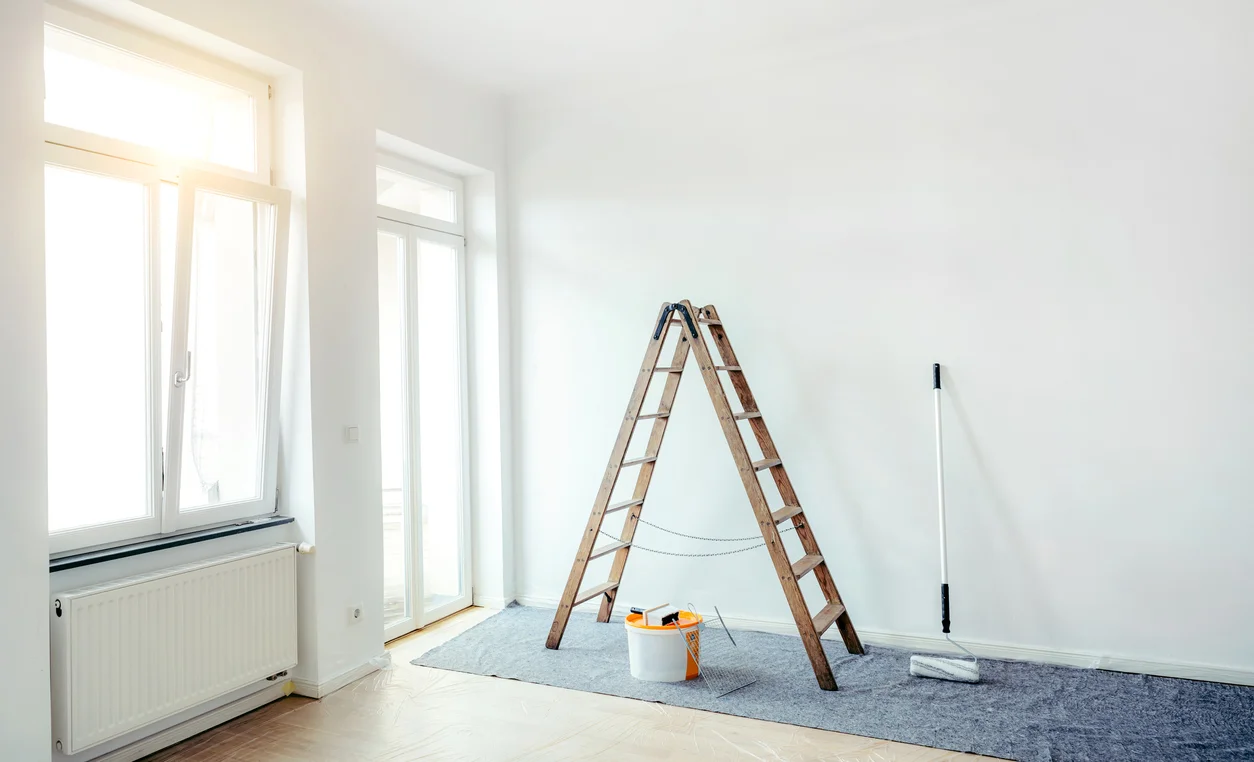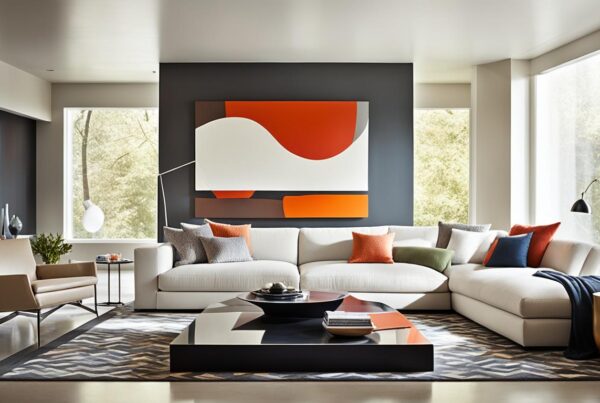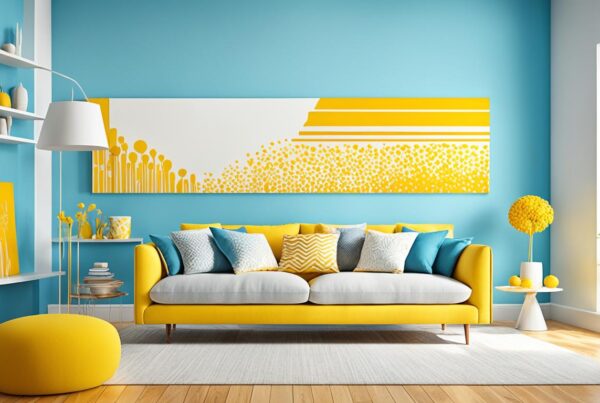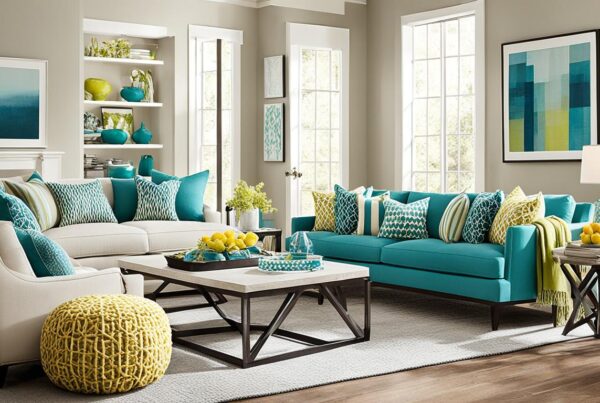Updating your home’s look with new paint colors is exciting. But, it’s not just about picking colors. You also need to think about the cost. That’s why I am here to help you understand the costs of hiring professional interior painters.
The average cost for interior painting is about $2.75 per square foot. If you add trims and ceilings, the cost might go up to $4.69 per square foot. Room height and location can change the cost too. For high rooms, prices could increase by 20-40%. And prices can vary by location. For example, Denver’s rates might be 10% higher than Chicago’s.
Painting your home in colder months can save you money. It’s often easier to find professional interior painters during this time. Plus, their rates might be lower as well. So, winter could be a smart time to plan your painting project.
Key Takeaways
- Knowing the average interior painting costs helps you budget.
- The size and layout of your room are important for cost estimates.
- Painting during winter might save you money.
- Where you live can affect how much you pay for labor. For instance, Denver versus Chicago.
- Remember, higher ceilings mean higher costs.
- Choosing to paint during less busy seasons could be cheaper.
Understanding the Basics of Interior Painting Costs
Interior painting is not just for looks. It also adds value to your house. The cost can change a lot based on paint type, wall texture, and where you live. Knowing about different kinds of paints and costs can help you stick to your budget.
Factors Affecting Painting Costs
Many things can change how much you’ll pay for interior painting. The size of your space, wall conditions, and the paint details matter a lot. Walls with texture need more work. This can make the job pricier and take longer.
Calculating Cost Based on Square Footage
Figuring out the cost of painting your home can make budgeting easier. Costs usually go from $1 to $3 for every square foot. These numbers should include cleaning walls, fixing them if needed, and applying two paint layers. Choosing top-notch, eco-friendly paints might cost more now. But, they last longer and are healthier for your home.
Seasonal Fluctuations in Pricing
Think about when you want to paint. Costs can drop during slow seasons. If you plan your project for these times, you could save money. This way, you might afford better paints without going over budget.
Knowing about materials, labor, and the best time to paint helps a lot. This knowledge will make your painting project look great without spending too much. Whether it’s a small room or the whole house, these tips will help you stay on track.
Preparing Your Home for Professional Interior Painters
I’m getting ready for a big change with interior house painting. It’s all about good prep for top-notch results. It’s more than choosing colors. It’s making sure my home is ready for the pros. Having painters in isn’t just for looks. It’s about smart planning and doing things right.
The Importance of Room and Surface Preparation
Every artist starts with a clean canvas. And it’s the same for painting walls. I start by cleaning, mudding flaws, and sanding for smoothness. This makes the surface ready for even paint, laying the base for perfect walls and trim.
Selecting the Right Interior Paint Finishes
The paint finish changes the room’s look and feel. Matte, glossy, or satin finishes mix light and texture in fun ways. This choice affects the room’s mood and how big it feels.
Why Primer is Crucial for Long-Lasting Results
Primer is key, even though it’s easy to skip to color. It makes colors stick better and last, especially with big changes. This first step keeps the finish strong and looking great for years.
Taking these steps seriously helps the painting pros do their best. It’s not just about color. It’s about honoring the work for superb results. This makes my investment in professional painting truly worthwhile.
Cost Breakdown of Residential Interior Painting
Diving into residential interior painting, I learn how costs work. This helps me plan my budget. Sticking to the best home interior paint colors and choosing professional interior painters shows costs clearly.
Paint cost is big in this. Prices change a lot. For example, premium brands like Sherwin-Williams and Benjamin Moore may ask $50-$70 for each gallon. Yet, Lowes or Home Depot might offer paint for $30-$45 per gallon. This choice affects the look and lasts of the paint.
Other needs like tape, rollers, and drop cloths are around 20% of paint price. If rooms are tall or tricky, I might need ladders or poles. These could cost an extra $125 – $450.
Labor costs take up most of the budget. Professional interior painters look at how big and tough the job is. Room size and wall condition matter a lot. Knowing about interior painting costs helps me talk and plan better.
| Cost Item | Price Range |
|---|---|
| Premium Brand Paint (per gallon) | $50-$70 |
| Economical Brand Paint (per gallon) | $30-$45 |
| Painting Supplies | 20% of paint costs |
| Special Equipment | $125-$450 |
| Labor | Varies by project |
Exploring residential interior painting costs is as vibrant as my color picks. By understanding each part, I make smart choices. This ensures great looks without overspending.
The Hidden Costs of DIY Interior Wall Painting Techniques
At first glance, painting your walls by yourself seems like it saves money. But, there are hidden costs that can surprise you. These extra expenses make your DIY project less cheap than you thought, especially with eco-friendly paint or special finishes.
Equipment and Material Expenses
Buying the right tools for painting is important and can be costly. You need brushes, rollers, painter’s tape, and tarps. Also, paints that are better for the environment often cost more than regular paints. Here’s a quick look at what you might spend:
| Material | Cost |
|---|---|
| Brushes and Rollers | $25 – $50 |
| Painter’s Tape | $7 – $15 |
| Eco-friendly Paint (per gallon) | $40 – $60 |
| Tarps/Drop Cloths | $10 – $25 |
Time Investment and Potential Risks
Time is a big factor in DIY painting. It might take days for beginners, unlike pros who are fast. There’s also a big chance of making mistakes. Mistakes like putting on paint wrong or not getting the wall ready right can add more time and cost.
DIY painting might seem fun, but don’t forget the hidden costs. Think about the price of quality paints and the time you need. These factors can change how you see the project’s real cost.
Choosing the Right Home Interior Paint Colors and Themes
Choosing Residential Interior Painting means more than liking a color. It’s about mood and how the room works. Whether updating a small bedroom or the whole house, Home Interior Paint Colors shape its look and feel.
Impact of Color on Perceived Space and Mood
Picking the right color makes a small room feel bigger. Or it can make a dark place warm and inviting. Light and bright colors open up a room and cheer us up. Dark colors make a room snug and private. Interior Paint Finishes also play a role in how light reflects, affecting the mood.
Navigating Color Trends and Personal Preferences
Trends matter, but your taste keeps your home feeling like it’s truly yours. Neutral colors are smart. They last longer and go with different decorations easily. Using Painting Interior Trim that contrasts or matches can add depth to your space.
| Color Type | Space Enhancement | Mood Influence |
|---|---|---|
| Light and Bright | Expands Space | Uplifting and Energizing |
| Dark and Rich | Cozies up Space | Intimate and Grounding |
| Neutral and Timeless | Adaptable to Changes | Calm and Versatile |
Choosing Home Interior Paint Colors and themes sets your home’s tone. Think about how you use rooms, the natural light, and color flow. This way, your home isn’t just functional. It’s also a beautiful, peaceful place to be.
Residential Interior Painting: Hiring Professionals vs. DIY
Choosing between residential interior painting on your own or hiring professional interior painters is big. It involves thinking about interior painting costs, how much time you have, and what you want at the end. You have to decide what matters most to you.
Hiring pros costs more at first but has big benefits. Professional interior painters know how to work with eco-friendly interior paints. They make your walls look amazing, even if they are not perfect to start with. They finish the job fast and right.
Doing it yourself saves money at first and feels great when you’re done. But, it takes a lot of time and hard work. If you’re not skilled, the outcome might not be what you hoped. You might have to pay more to fix mistakes.
| Criteria | DIY Painting | Professional Painting |
|---|---|---|
| Cost | Lower upfront, potential for extra expenses | Higher upfront, cost-effective long term |
| Time | Substantial personal time investment | Quick and efficient; no personal time required |
| Quality | Varies based on individual skill | Consistently high, professional finish |
| Materials | Responsibility to select and purchase | All materials provided, includes eco-friendly interior paints |
Choosing between DIY and professional painters depends on what you value. It’s about control and saving money versus ease and quality. Your choice impacts your home and its value.
Conclusion
In my journey through home painting, I’ve learned a lot. This includes both the beauty and practical sides. Choosing paint colors, paint quality, room prep, and deciding to hire pros or DIY all matter a lot. The success of a project depends not just on the color but on how well it’s applied.
Though costs are important, the value pros bring is huge. Their expertise turns spending into a great investment for my home. Knowing about prices helps me. It lets me balance spending and beauty well.
My home is my haven, and paint choices change its feel. I might choose trendy deep-navy or classic eggshell white. Now, I see painting more as art than just a task. From picking brushes to the final touches, I know how to make my space beautiful and smart.
FAQ
What are the key factors that affect interior painting costs?
The size of the area, paint quality, job complexity, and wall condition matter. Labor rates in your area affect the cost too. Choosing eco-friendly paint and detailed work like trim painting also influences the price.
How do professionals calculate the cost based on square footage?
Costs are estimated by measuring the space’s square footage. Painters factor in the number of paint coats and prep work. Prices, including materials, range from .75 to .69 per square foot.
Can the time of year affect interior painting pricing?
Yes, the season can change pricing. Winter often brings lower prices due to less demand. But prices can rise in warmer months because more people want painting services.
What is involved in preparing my home for professional painters?
Getting ready means cleaning walls, fixing damage, and sanding. Floors and furniture need protective covers. Applying primer is crucial for a good finish. Also, cover hardware and protect frames with painter’s tape.
Why is selecting the right interior paint finish important?
Different finishes affect the look and durability of walls. Choices range from flat to gloss. The best finish depends on room use, light, and how much handling the surface gets.
Why is primer crucial for long-lasting painting results?
Primer ensures paint sticks well and hides stains. It makes paint last longer, requiring fewer topcoats. This is especially true when changing paint colors.
What additional expenses might I incur if I decide to paint my interior walls myself?
DIY painting means buying brushes, rollers, and drop cloths. You might need ladders too. Mistakes can add extra costs for fixing. Proper disposal of paint and supplies may cost more too.
How much time should I expect to invest in a DIY painting project?
Painting it yourself takes time, including prep and cleanup. Without professional skills, it can take much longer. This is true especially for big jobs or detailed work.
How does the choice of home interior paint colors influence the feel of a room?
Color choice greatly affects a room’s look and feel. Light colors make rooms seem bigger. Dark colors can make them feel cozy. Pick colors that match your decor and lighting.
Should I factor in color trends when selecting interior paint?
Trends can be tempting, but your personal taste matters more. Trends come and go. Pick colors you will love for a long time, balancing trendiness with longevity.
Is it better to hire professional interior painters or to paint my home myself?
The choice depends on your budget, time, and what you want. Pros offer quality and efficiency. DIY saves money but might not look as good or be as reliable.




